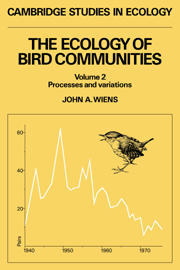Book contents
- Frontmatter
- Contents
- Preface
- Acknowledgments
- Part I Interpreting community patterns: process hypotheses
- 1 Competition
- 2 A case study: interactions among nectarivores
- 3 Beyond competition: other factors influencing community structure
- Part II Community variation in time and space
- Part III Prospects
- References
- Author index
- Subject index
3 - Beyond competition: other factors influencing community structure
Published online by Cambridge University Press: 18 December 2009
- Frontmatter
- Contents
- Preface
- Acknowledgments
- Part I Interpreting community patterns: process hypotheses
- 1 Competition
- 2 A case study: interactions among nectarivores
- 3 Beyond competition: other factors influencing community structure
- Part II Community variation in time and space
- Part III Prospects
- References
- Author index
- Subject index
Summary
Patterns in avian communities have usually been explained as the results of interspecific competition, and other processes or factors that might contribute to the patterns have been given only superficial consideration or ignored. Finding that individuals of an island population of a species differ in behavior from their mainland conspecifics, for example, ecologists often have not asked what factors might account for the differences but instead have explained the patterns solely in terms of the absence of presumed competitor species on the island. In the previous chapters, I have argued that this approach is overly simplistic and sometimes logically invalid. Even if competition is shown to occur, this does not mean that other processes or factors are absent or unimportant. Only if the patterns predicted on the basis of these other factors differ from those expected from competition can one justly conclude that competition is the primary cause of the patterns and that the contributions of other processes are unimportant. Testing such alternatives is a pivotal feature of any logical approach to scientific explanation (see Volume 1).
According to Schoener (1982), the challenges to the competition paradigm that developed during the late 1970s followed several avenues: (1) mathematical modification of the theory, (2) statistical re-evaluation of the patterns through the use of null models, (3) consideration of the influences of environmental variability, (4) emphasis of the role of predation, and (5) determination of the meaning of resource overlap. Of these areas of concern, only the fourth really emphasizes an alternative process; the first and fifth involve adjustments of competition theory, the second deals with the patterns, and the third explores the constancy or intermittency of the competition process.
- Type
- Chapter
- Information
- The Ecology of Bird Communities , pp. 89 - 140Publisher: Cambridge University PressPrint publication year: 1989



